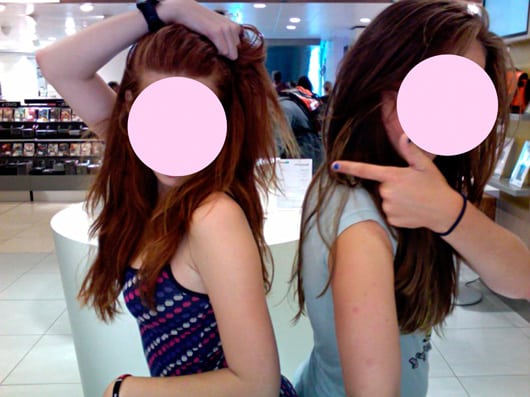Artist Cyberstalks Two 14-Year-Olds Girls For Art Exhibit
 Showroom computers are pretty common in stores nowadays. Everywhere from Apple To Best Buy, customers who are looking to fiddle with the newest gadgets are usually encouraged to snap photographs of themselves and make videos, which many browsing tech aficionados often just leave on the computer. So when the 28-year-old Dutch artist Willem Popelier wandered into a showroom and found 91 pictures and 2 movies made by two young girls, he had the perfect addition to his art piece on digital narcissism.
Showroom computers are pretty common in stores nowadays. Everywhere from Apple To Best Buy, customers who are looking to fiddle with the newest gadgets are usually encouraged to snap photographs of themselves and make videos, which many browsing tech aficionados often just leave on the computer. So when the 28-year-old Dutch artist Willem Popelier wandered into a showroom and found 91 pictures and 2 movies made by two young girls, he had the perfect addition to his art piece on digital narcissism.
Willem’s piece entitled “Showroom Girls” was presented over the summer in Amsterdam. Part found art, part research, part performance art, Willem used the photographs on the showroom to locate other images of the girls on the web. This was actually pretty simple considering that one of the young ladies was wearing a necklace with her name on it. A few clicks around Google later, Willem as able to identify both girls on a variety of social media platforms with access to even more photographs and details about their lives. [tagbox tag=”teenager”]
Willem took the photographs from the showroom and obscured their faces for the exhibition. He also included a printer which prints one of the girl’s tweets from a whole year. Her Twitter handle and actual tweets are blurred so as an audience member, you’re completely prevented from identifying the girl. But the artist does nevertheless identify the work as voyeuristic. He told the museum Foam, where his work appeared:
The work “Showroom Girls” is in a way very voyeuristic. Especially in the light of our “relationship”: the girls are 14 years old, I am a “dirty” man who is 28 years old – twice their age – and I am looking at them and collecting their digital traces. On top of that, I have the power to make these details public.
Although Willem did consider contacting the girls about his art piece, he ultimately decided not to because he was aiming to show how a new generation of young people digitally exploit themselves over the web. The artist did not wish to display anything about the girls as individuals. He told the museum that “the girl with the necklace,” like many web-savvy teens, has a very public life on the internet and that he didn’t use any information that wasn’t publicly accessible:
The girl with the necklace shares almost everything with the world via Twitter. By now she has nearly 40.000 tweets on Twitter. The things she shares in these tweets are futile and banal. She tweets about school, going out, about her new Blackberry, songs she listens to and the things she sees on tv….it is not about what she twitters but that she twitters and in what extend. She is part of a new generation of people who think of sharing as a natural extension of themselves. This is what I want to visualize: I want to share how this generation shares.
When Willem stumbled upon the photos in the showroom in 2010, the images were already one year old raising even more questions as to why the girls took so many, and furthermore, why they didn’t delete all of them. While the scenario of anyone scouring the web for images of underage girls is irksome, Willem’s project evokes even larger theories as to why young people feel compelled to share so much of themselves on the web — and adults for that matter. Even if, as Willem observes, the avid tweeting and Facebooking is just “a natural extension of themselves,” when does that expression of daily life begin to compromise the safety of kids?
After all, if the well-intentioned artist can grab a few online pictures and see a 14-year-old girl’s Twitter account, than those of a more sinister ilk surely can.
(photo: willempopelier.nl)






